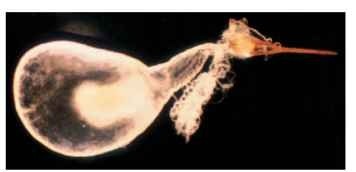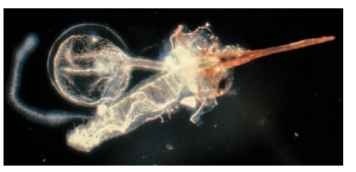
Venoms are biologically active liquids delivered into or onto another organism through a piercing structure such as a mouthpart or sting apparatus and often resulting in pain, tissue damage, paralysis, or death in the target organism. Insects contain more venomous species than all other groups of terrestrial animals combined. Within insects, venoms evolved numerous times to occupy positions in groups as diverse as ants and wasps to biting bugs, robber flies, and stinging caterpillars. Venoms empower insects with unique properties that enable them to achieve far greater effects or impacts on target organisms than would be expected for such small animals. A tiny wasp weighing far less than a milligram can rapidly paralyze a caterpillar hundreds of times its own size, and a single attacking honey bee can send a million times larger human into panicked flight.
Venoms provide the biological means for insects to break free from many ecological restraints, thereby expanding their opportunities to exploit the world around them. One could argue that the omnipresence of ants in today’s world is the result of venom combined with a social structure in ancestral ant lineages. Parasitic braconid and ichneumonid wasps, whose species number more than 100,000, with probably several times that number undescribed, owe their successful speciation, in part, to the ability of their venoms to facilitate the use of a variety of host organisms. Honey bees (Apis spp.) have become dominant pollinators throughout much of the world, in large part because their venomous stings have enabled them to defend against a multitude of large, often intelligent predators. Without their effective defensive venoms, honey bees could not prevent the plunder of their large stores of honey and pollen, which they must maintain to overcome long seasonal periods of harsh conditions. The biological roles, operation, and properties of insect venoms provide dazzling illustrations of the successful adaptation of insects to their environment.
BIOLOGICAL ROLES OF VENOMS
Venoms serve two primary roles—defense and prey capture. In most lineages, the ancestral role was the use of venom for prey capture. The venoms of many taxa retain primary roles of prey capture. Examples are numerous and include many families or superfamilies of bugs, beetles, flies, neuropterans, and especially parasitoid and solitary aculeate wasps. Many successful insects have taken venom use another step—to defend against predators. The mere fact that insects such as honey bees, yellowjackets, and hornets are so universally familiar attests to the effectiveness of their defensive venoms. Defensive venoms are present in all social wasps, many ant species (including fire and harvester ants), some solitary bees and wasps, a few bugs, and a variety of spiny caterpillars. In many of the hymen-opterans, the role of venom for prey capture has been entirely replaced by a role in defense. Some wasps and ants retain both roles, with the spider wasps (Pompilidae) and fire ants (Solenopsis spp.) as conspicuous examples. In caterpillars, which never used venom for prey capture, the defensive role evolved independently.
EVOLUTION OF VENOMS
Most venoms evolved from preexisting digestive or reproductive systems. Exceptions are the lepidopteran caterpillars, for which the origin of their venomous spines is unclear. The venoms of all other non-hymenopteran insects evolved from salivary or gastric secretions associated with the mouthparts and digestion. In some taxa, the venom toxins are salivary secretions injected into the prey. In others, the toxins are regurgitated from the gut into the prey through piercing mouthparts. Asilid flies use the latter form of venom delivery.
The Hymenoptera evolved an entirely different venom system. In Hymenoptera, the stinger evolved through modification of the female ovipositor, and venom evolved from the accessory reproductive glands ( Figs. 1 and 2 ). Consequently, only female Hymenoptera can sting. The lack of ability to sting and defend a colony against large predators is considered a primary reason for the failure of males, often called drones, of honey bees and social Hymenoptera to meaningfully defend their colonies against predatory assaults or to help the colony via foraging.

FIGURE 1 Fire ant (S. invicta) sting apparatus including the stinger, a derived ovipositor, with attached large venom sac and small Dufour’s gland, which are derived accessory reproductive glands.

FIGURE 2 Pogonomyrmex badius harvester ant sting apparatus including the round venom sac with attached free filament that collects materials from the hemolymph for venom synthesis, and the tubular Dufour’s gland.
VENOMS USED FOR PREY CAPTURE
Two basic types of venom are used for prey capture: those that kill outright and those that only paralyze or alter prey physiologically. Prey paralysis is important for many insects that provide prey for their young. Prey that is paralyzed but still living does not spoil rapidly, giving larvae time to feed and grow. Insects that kill their prey with venom tend to consume it immediately, though exceptions to this rule exist. Wasps that use their venoms to provide a living host for their larvae and oviposit one or more eggs in or on the host are often called parasitoids. The venoms of parasitoids span a paralysis range from no paralysis to temporary paralysis to permanent paralysis. Venoms causing no paralysis, or short-acting paralysis, are found in many species of wasps in which the parasitized host continues feeding and growing until just before it dies, all the while harboring and protecting the par-asitoid larvae from environmental and predatory risks. The venoms of these wasps often contain mutualistic viruses and other components that not only help protect the oviposited eggs from host encapsulation and immune defenses, but also alter the hormone balance inside the host to prevent molting to the next stage of development. If the host is in a protected environment, as exists for wax moth larvae in combs of a dead honey bee colony, an extremely potent venom that causes total and permanent paralysis, like that of a parasitoid wasp such as Bracon hebetor, can be beneficial.
Hunting wasps are another group of solitary wasps that use venom for prey capture. These wasps include familiar sphecid, eumenid, and spider wasps plus a variety of other families of aculeate wasps. Like classical parasitoid wasps, hunting wasps possess venoms with a large activity span. For example, the sphecid Larra analis uses venom to paralyze its mole cricket hosts temporarily. At the other extreme, represented by the beewolf Philanthus triangulum and tarantula hawks (Pepsis spp.), the hunting wasps paralyze the honey bee and tarantula prey permanently. No evidence for injection of viruses or factors altering the host’s endocrine or immune systems exists for hunting wasps. The majority of parasitoid and hunting wasp venoms are of little value for defense against predators. In many groups, the wasps cannot, or do not, even attempt to sting predators; in others, the pain and activity of the venom, at least to humans, is trivial. Some exceptions exist: most pompilid and mutillid wasps; some eumenid, tiphiid, and bethylid wasps; and a very few sphecid wasps can deliver painful stings; however, none of these venoms is meaningfully toxic to mammals.
DEFENSIVE VENOMS
Because of the extreme size difference between vertebrates and insects, insects are vulnerable to attack by vertebrate predators. Once such a small creature is captured by a large predator, typical defenses such as kicking, scratching, and biting are all but useless. A very few defenses, particularly potent venomous stings and allomones, can neutralize the predator’s size advantage and blunt attacks. A key feature promoting the efficacy of defensive venoms is the ability of the sting apparatus to bypass the predator’s skin and external defensive barriers and inject venom directly into sensitive tissues. Venoms function as defenses in several ways. First, they cause pain. Second, they can cause body or tissue damage, or death. Beyond these primary activities, venom can have defensive value based on its nasty taste, and, possibly, on its ability to induce allergic reactions. Honey bee venom illustrates the value of a repugnant taste of a venom: birds and other vertebrates were presumed to reject worker bees while readily devouring drones because of the ability of workers to sting. For example, Western Kingbirds selectively prey on drone honey bees, which they manipulate entirely with their hard bill until the prey can be quickly swallowed, head first. The handling and speed of consumption suggested to the author that a kingbird could consume worker bees without being stung. Why then were workers rejected? A suspected, but unconfirmed, explanation was revealed upon consumption of whole frozen drone honey bees and abdomens of workers. Drones were generally palatable. In contrast, worker abdomens were noisome, possessing a bitter and “hydrolytic” taste, a taste confirmed by sampling of an isolated venom sac to be venom.
No direct evidence confirms a defensive value for venom allergy. However, three lines of reasoning suggest that such a value might exist. First, the 1 to 4% incidence of allergic reaction to insect stings in the general human population is disproportionately high compared with allergy to other proteinaceous substances. Second, observations of social interactions among human groups in which one individual experiences an allergic reaction to a sting reveal that fear of the culprit stinging insect is shared among the whole group. Primates and other intelligent social mammals, major potential predators of social insects, likely also learn to avoid the stinging insects by observation of the plight of a group member. Third, an allergic reaction impairs an individual’s ability to avoid its own predators, to obtain food, and to reproduce as effectively as if no reaction had occurred. Consequently, the genes from an individual that attacks stinging insects and suffers a reaction are not as likely to be passed to future generations. Such “genetic learning” would be a consequence of allergic reactions.
Pain, the most notorious property of an insect sting, is key for the instant defensive value of venom. Pain is the biological signal that indicates to an organism that bodily damage has occurred, is occurring, or is about to occur (Fig. 3). Consequently, pain is a signal that must be heeded and acted upon if an animal is to enhance its own survival and fitness. Pain acts to stop an attacking predator and to cause it at least momentarily to assess its own risk situation. In the meantime, the stinging insect gains valuable time for escape or further defense. Because pain cannot be measured easily or precisely, exact values to

FIGURE 3 Painful local reaction illustrating central tissue damage and surrounding inflammation induced by a honey bee sting.
use for comparing the effects of different venoms on potential predators are unobtainable. To provide a means for comparison, a pain index was developed, based on a scale of 0 to 4. Zero indicates that the stinging insect is too small or otherwise unable to pierce the human skin; 2 is the central value, as represented by the pain of a honey bee sting; and 4, the top of the scale, is typically described as causing immediate, excruciating, totally debilitating pain that completely eliminates the ability of the stung individual to continue to act in a normal fashion. Table I lists pain values for some common insects.
TABLE IPain Rating and Lethality of Common Insect Venomsa |
|||
| Species | Common name | Pain ratingb |
Lethalityc |
| Lasioglossum spp. | Sweat bee | 1 | n/a |
| Sceliphron caementarium | Mud dauber wasp | 1 | n/a |
| Solenopsis invicta | Fire ant | 1 | n/a |
| Eciton burchelli | Army ant | 1 + | 10 |
| Sphecius grandis | Cicada killer wasp | 1 + | 46 |
| Myrmecia gulosa | Bull ant | 2- | 0.18 |
| Dinoponera gigantea | Giant ant | 2 | 12 |
| Xylocopa californica | Carpenter bee | 2 | 26 |
| Dolichovespula maculata | Bald-faced hornet | 2 | 6 |
| Bombus impatiens | Bumble bee | 2 | 12 |
| Apis mellifera | Honey bee | 2 | 2.8 |
| Vespula germanica | German yellowjacket | 2 | 2.8 |
| Polistes arizonensis | Paper wasp | 2 | 2.0 |
| Polistes canadensis | Red paper wasp | 3 | 2.4 |
| Dasymutilla klugii | Velvet-ant wasp | 3 | 71 |
| Pogonomyrmex maricopa | Harvester ant | 3 | 0.125 |
| Pepsis formosa | Tarantula hawk wasp | 4 | 65 |
| Synoeca septentrionalis | Warrior wasp | 4 | 3 |
| Paraponera clavata | Bullet ant | 4 | 1.5 |
aFor a more complete list, see Schmidt (1990).
bBased on a scale ranging from 0 to 4; 4 is the highest score.
cMeasured as milligrams of venom per kilogram of body weight in mice; the
smaller the number value, the more potent the venom. (n/a=not available.)
Pain, itself is a bluff, mimicking damage and deceiving a would-be predator into believing that it has been injured. Unless confirmation of injury follows, an intelligent animal quickly learns to ignore the pain and continue with its attack. Beekeepers provide a familiar example of the principle—upon learning that bee sting pain does not translate into actual damage or risk, they continue their activities, often receiving scores of stings in a day. If damage did occur to beekeepers, the profession would have become extinct long ago. A minority of beekeepers does experience damage in the form of large local or allergic reactions, and these individuals usually abandon the profession. To avoid the limiting problem associated with pain, venoms of many insects have evolved a step further to the stage of “truth in advertising”: pain is the advertising; toxicity is the truth. If the pain signal is associated with damage, then predators cannot easily bypass the pain signal. Venom toxicity is most easily measured in terms of its ability to cause death in an animal.
Table I also rates the lethality of representative insect venoms. Often, but not always, increased pain parallels increased lethality, and hence the tandem evolution of both “advertising” and “truth.” Notable venoms on the list are those of the harvester ants (Pogonomyrmex), the most lethal insect venoms in the world, which cause rather nasty intense pain that lasts for 4 to 8 h, and bullet ants (Paraponera), the world’s most painful venomous insects, which also have a respectable lethality. Australian bull ants (Myrmecia) and tarantula hawks (Pepsis) present curious cases: bull ants are rather lethal, yet they induce relatively little pain; tarantula hawks cause a most intense pain equaling that of bullet ants for 2 to 3 min, yet they possess no vertebrate lethality. The explanation for this discrepancy between pain and lethality is unclear for bull ants, but for tarantula hawks, the explanation might be that Pepsis must permanently paralyze its spider prey without killing them.
ECOLOGY AND EVOLUTION
Insect venoms have played an enormous role in ecology and evolution. For parasitic and hunting wasps, venoms have provided the means to expand the menu of hosts as food sources. This in turn allowed, and continues to allow, isolation of breeding populations and rapid speciation of the wasps. Via their increased impact, wasps alter the foraging and defensive behaviors of their host species, with a ripple effect insofar as other predators and parasitoids are influenced. The influence of defensive venoms is even greater. The defensive potency of venoms provided venomous insects the freedom to enhance further their defensive strengths through the evolution of secondary defenses of aposematism and mimicry. Warning colors, sounds, or chemical signals used in conjunction with the honest threats of damage from the sting provide venomous insects with the ability not only to defend against potential predators, but also to reduce risks of being attacked. After one or a few species develop aposematic signals, other venomous insects can become Mullerian mimics of the signals. The system opens to “cheaters”—which are not noxious—to become Batesian mimics of the venomous models.
For most species, freedom from one or more predators, or reduced predatory pressure, provides wonderful behavioral and evolutionary opportunities. Secretive species may expand their niches into more conspicuous environments or to increased periods of time, thereby reaping the benefits of increased quantity and variety of resources. Examples of this are brightly colored bumble bees, social wasps, and spider wasps that can forage during daylight hours in open environments, free from most threats from predatory birds and lizards. Likewise, venomous ants can exploit daylight periods, open areas, or conspicuous areas in the vegetation.
All other effects of venoms pale in comparison to their impact on the evolution and maintenance of sociality in Hymenoptera. Social wasps, bees, and ants account for a huge percentage of the individuals and biomass of most ecosystems, especially tropical systems. Social wasps are important predators of other arthropods, social bees are responsible for much of the pollination of plants, and ants are major predators and influences on other animals. Insect sociality evolved partly through kin selection in which related presocial individuals that cooperated had higher inclusive fitness (the successful passing on of their genes to the next generation) than did individuals that did not cooperate. In Hymenoptera, the evolution of sociality, and its maintenance, was possible, in large part, because of defensive venoms. Social insects and their nests brimming with defenseless brood and/or food stores represent bonanzas for predators capable of exploiting them. As colony size increases, larger and more determined predators will attempt to exploit a colony’s brood or food cache. Venoms provided the means, both proximate and ultimate, for colony defense against destruction. Once established, sociality in Hymenoptera could progress from small simple social structure to highly organized structures via the evolution of increasingly potent venoms and other defenses. Populous, highly organized social species dominate and rule most environments.
